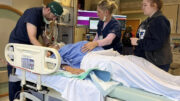PennDOT District 1 press officer Jim Carroll said Tuesday that inspections of the Sugarcreek and Center Street bridges’ structural integrity has uncovered more damage than PennDOT had initially expected.
Sugarcreek Bridge
The historic Sugarcreek Truss bridge, which is more than 90 years old and used by more than 1,000 vehicles a day, was disassembled and moved so inspection of its structural components could begin.
Plans for the project involved disassembling the structure and moving the component steel parts to another location so they could be sandblasted and cleaned up. Contractors will reconstruct and resurface roadway approaches, install new concrete bridge approach slabs and update guiderail and pavement markings.
“We are finding more structural steel issues than we thought,” Carroll said. “We are trying to hold schedule on that but we still don’t know exactly what we are going to have to deal with. They are still inspecting the steel members and what we are finding is more issues,” Carroll said.
Contractors found more deterioration and more damage than what was initially expected after examining the steel members and sandblasting them. Carroll said sandblasting the steel unearthed more problems with the structurally significant steel.
Carroll said PennDOT hopes work on the bridge can still be completed by the department’s initial estimate of early November.
Center Street Bridge
Repairs on Oil City’s Center Street Bridge, a 172-foot long span that saw up to 6,800 vehicles a day, are also facing a possible delay.
The nearly $2 million project looks to add 50 years to the bridge’s lifespan by restoring and replacing deficient and old steel, installing new asphalt roadway approaches, new concrete bridge approaches, concrete sidewalks and curbs, refurbished hand railings, traffic signal work, updated drainage, landscaping and pavement markings, along with milling and paving on Center Street.
The six-month project was initially expected to be finished by the end of September, but Carroll said its completion could be delayed another month.
“It looks like it could conceivably be the end of October,” Carroll said. “It has just required a lot more repairs and fabricated steel work than what was anticipated.”
Carroll said one fascia beam had to be replaced on the upstream side of the bridge, which came as somewhat of a surprise to contractors.
“We knew we had to replace a lot of the structural steel on the downstream side,” he said.
Many of the fabricated steel repairs so far have been done to the substructure of the bridge, an area just below the deck.
“A lot of the deterioration that we found wasn’t evident until they did the shotblasting,” Carroll said.
Shotblasting is a process in which the bridge is wrapped in a giant canopy to contain pollutants and contamination as workers shoot a high speed stream of steel BBs to remove paint, rust and scale build-up from its structure.
“It showed more problems than were evident beforehand,” Carroll said. “We had to weld 3/8 inch steel plate on to some of the decks.”
Contractors also had to rehabilitate structural I-beams by welding steel plates on the vertical element, otherwise known as webbing.
“It will make some of the beams last a little longer so we get the best impact from this rehabilitation,” Carroll said.
The project has closed the bridge to traffic and a detour along the Route 8 bypass has been set up as repairs remain in progress.
Potential road repairs
Carroll also said PennDOT is aware of wear and tear on detour roads like Buttermilk Hill Road while the rehabilitation work is underway.
“We have noticed some roughness and some deterioration. We will look at a remediation plan and see what we are able to do and what we will have to do,” he said.
Buttermilk Hill Road is a state route and would fall under PennDOT’s care.
“We are keeping an eye on them and will come up with some kind of a plan for them,” he said.







































